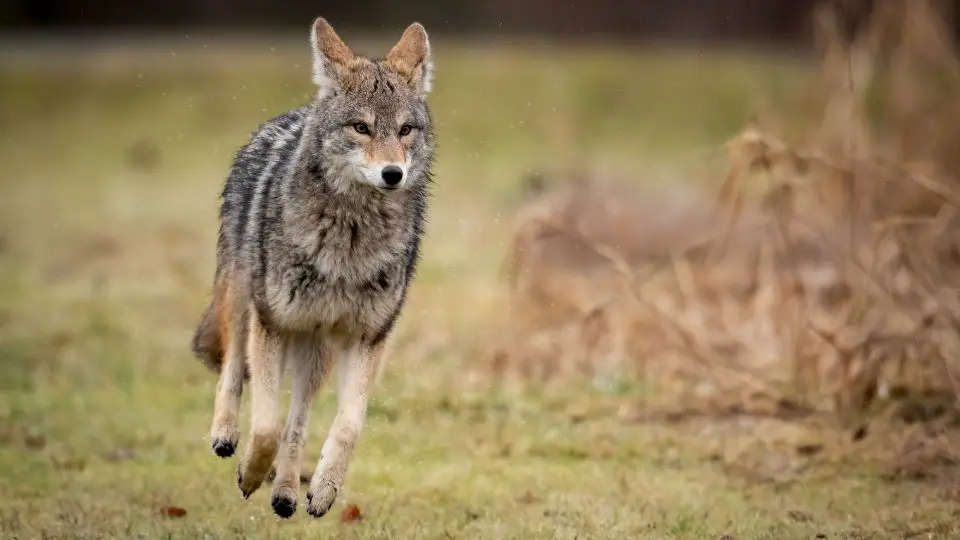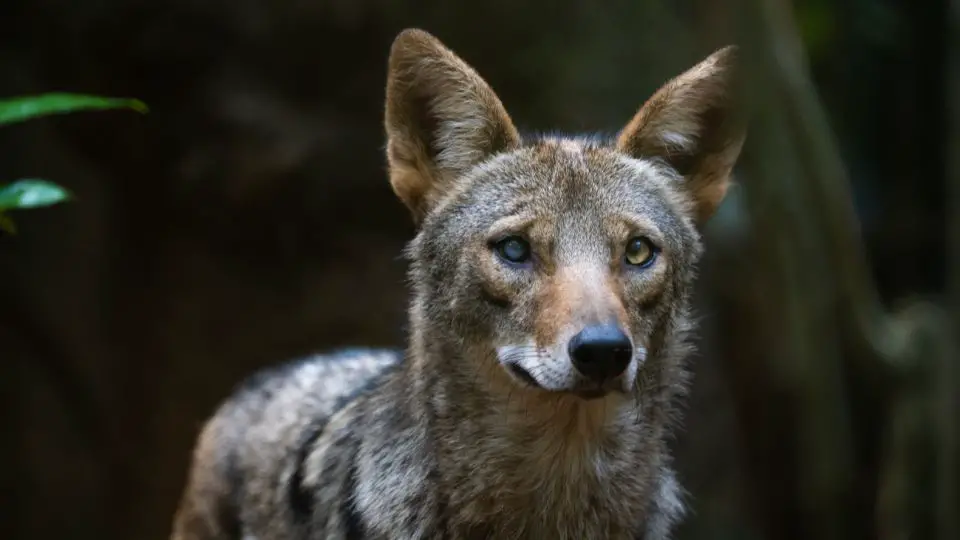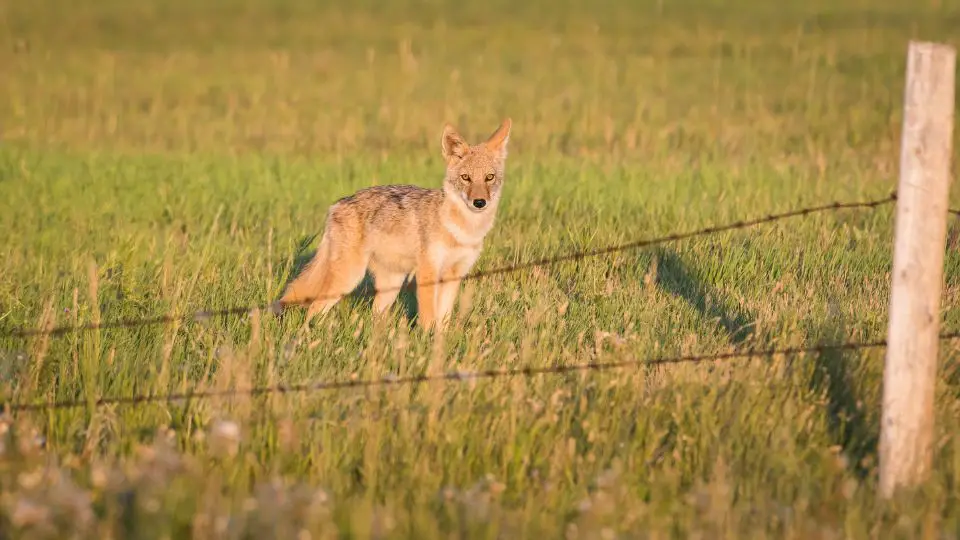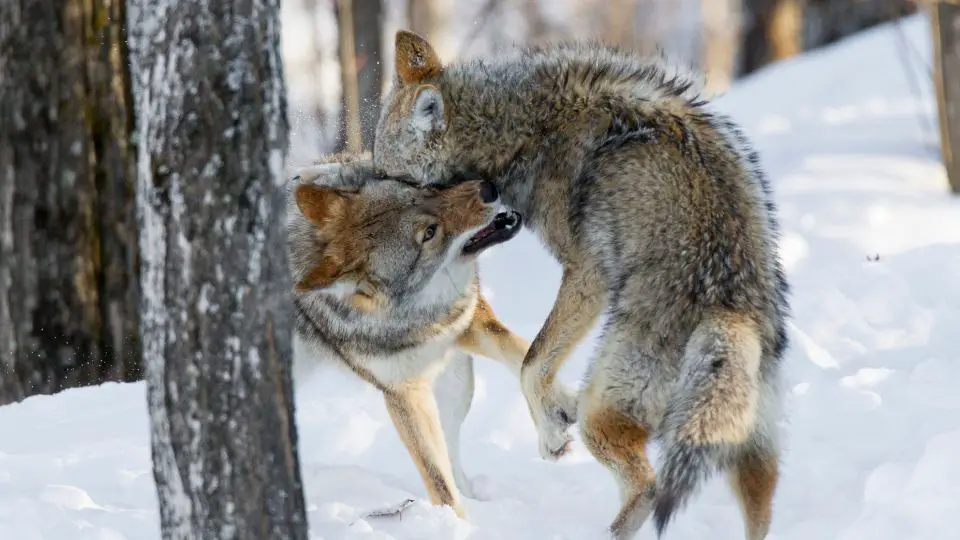Coyotes sometimes attack both feral and domesticated dogs. Coyotes attack dogs as prey or to gain or defend territory. Large dogs are less at risk of being attacked by coyotes.
Coyotes can be found in urban areas and rural areas across North America. No matter the location, coyotes pose a threat to dogs. Below is are 10 tips to protect your dog from a coyote attack:
- Walk your dog on a leash.
- Don’t feed wild animals.
- Walk with your dog on wide and busy trails.
- Avoid walking in areas with thick vegetation.
- Don’t walk in highly populated coyote areas around sunrise or sunset.
- Supervise your dog outside.
- Make your property unappealing to coyotes.
- Don’t feed your dog outside.
- Put an anti-coyote vest on your dog.
- Pick up your dog’s poop.
Table of Contents
Will a coyote attack my dog?
Coyotes may attack dogs, but it is rare for them to do so. How a coyote behaves around a dog depends on the type of dog. Coyotes view small dogs and puppies as prey.
They attack smaller dogs with their claws and teeth to eat them. Coyotes see large dogs as a threat. Coyotes attack larger dogs to fight for territory, food, or dominance. They don’t attack large dogs to eat them.
Coyotes mostly attack dogs that weigh less than twenty-five pounds. Coyotes grip small dogs in their mouth and shake them aggressively. Sometimes small dogs can escape this grip and run away.
Dogs will fight back while being attacked, but small and medium-sized dogs will usually lose in a fight against a coyote.
Canines and coyotes are related. Sometimes they will play with each other when they come into contact. They may chase each other and bite without the intent to harm.
Even if they are playing, injuries may occur. The coyote could accidentally hurt the dog or vice versa. Coyotes are wild animals and therefore are unpredictable. They could suddenly attack while playing.
Coyotes carry diseases that can be transmitted to dogs. Even if the coyote does not attack, it could still infect the dog by direct contact or contact with coyote feces.
Coyotes can give dogs diseases and transmit parasites including:
- Distemper
- Canine hepatitis
- Rabies
- Tularemia
- Mites
- Ticks
- Fleas

Can dogs sense when coyotes are around?
Dogs have a heightened sense of smell. They can smell the wildlife around them, including coyotes. Dogs can also use their superior sense of hearing to tell if a coyote is close.
They may hear a coyote howling or sense it moving in the bushes. Dogs are usually aware of their surroundings. However, each dog is different and may or may not notice if a coyote is nearby.
Are dogs afraid of coyotes?
Once a dog senses that a coyote is around, it may either act scared or it may chase the coyote. A frightened dog may whimper and cower close to your leg.
If the dog chases the coyote, the dog may attack the coyote first. With either reaction, the dog will be more alert. Physical signs of this attentiveness include a twitching nose and perked ears.
Each dog is different and will react somewhat differently to coyotes. Sometimes dogs have a desire to chase coyotes, just like their desire to chase squirrels.
Some dogs see it as their duty and responsibility to chase away the coyote. This may be as a way to protect their owner or their territory. Other dogs may chase the coyote as a way to play.
Small dogs are typically the type of dogs to be scared when coming near a coyote. They know coyotes are bigger than them, which is intimidating to small dogs.

How do I protect my dogs from a coyote?
Making your property unappealing to coyotes is one way to eliminate their presence and therefore attacks. You can take several actions at home to protect your dog from coyotes:
- Trim trees and bushes to reduce hiding spots for coyotes
- Remove food sources
- Secure trash cans
- Secure bird feeders
- Clean your grill
- Pick up fallen fruit and nuts from trees
- Feed your pets inside
- Don’t feed any wild animals that come onto your property
Intentionally feeding critters, especially coyotes, will keep them coming back for more food. Another way to make your property have less appeal to coyotes is to pick up dog poop.
Nearby coyotes will smell dog feces and hunt for the dog as a meal. If your dog is outside at home—such as playing in the backyard—don’t leave the dog unattended. Keep an eye on dogs to ensure safety.
If a coyote approaches your dog on your property, clap loudly and make other loud noises to scare it off. You can also throw items like sticks and small rocks at the coyote.
Coyotes, in fact, have a natural fear of humans. So, if you are outside with your dog, it is more unlikely for a coyote to approach. While taking your dog on a walk, be sure to do so safely to decrease your chances of a coyote attack.
Walk your dog on a non-retractable leash to pull your dog back if you happen to run into a coyote. Use paths that are open and busy with people. Coyotes are nocturnal, but they can still be seen during the day.
Walking late at night or even early in the morning increases the chances of a coyote attack. If you commonly walk your pet at night, carry a flashlight.
What to do if you see a Coyote
If you see a coyote while alone or with your pet dog, don’t run away. If you have your dog with you, keep your dog close, whether that be on a leash or by holding your dog.
Don’t turn your back on the coyote. Walk away slowly and walk backward if necessary to maintain eye contact with the coyote.
Pet owners should keep dogs up to date on vaccinations. Vaccinations will help keep your dog healthy if they get attacked by a coyote. If your dog gets attacked by a coyote or interacts with a coyote, seek medical attention immediately.

What kind of dog keeps coyotes away?
Large dogs with protective instincts are good at keeping coyotes away. Here are some dog breeds that are big enough to have the ability to win a fight against a coyote:
- Sarplaninac
- Kangal
- Irish Wolfhound
- Alabai
- Akbash
- Dogo Argentino
- Tosa Inu
- Mastiff
Large dogs are not the only dogs capable of keeping coyotes away. Sometimes the sound of any dog barking will make coyotes leave.
If the dog barks are loud, deep, and intimidating, it is likely to deter coyotes. If their barking is quiet and makes more of a yipping noise, it likely won’t scare away a coyote.

